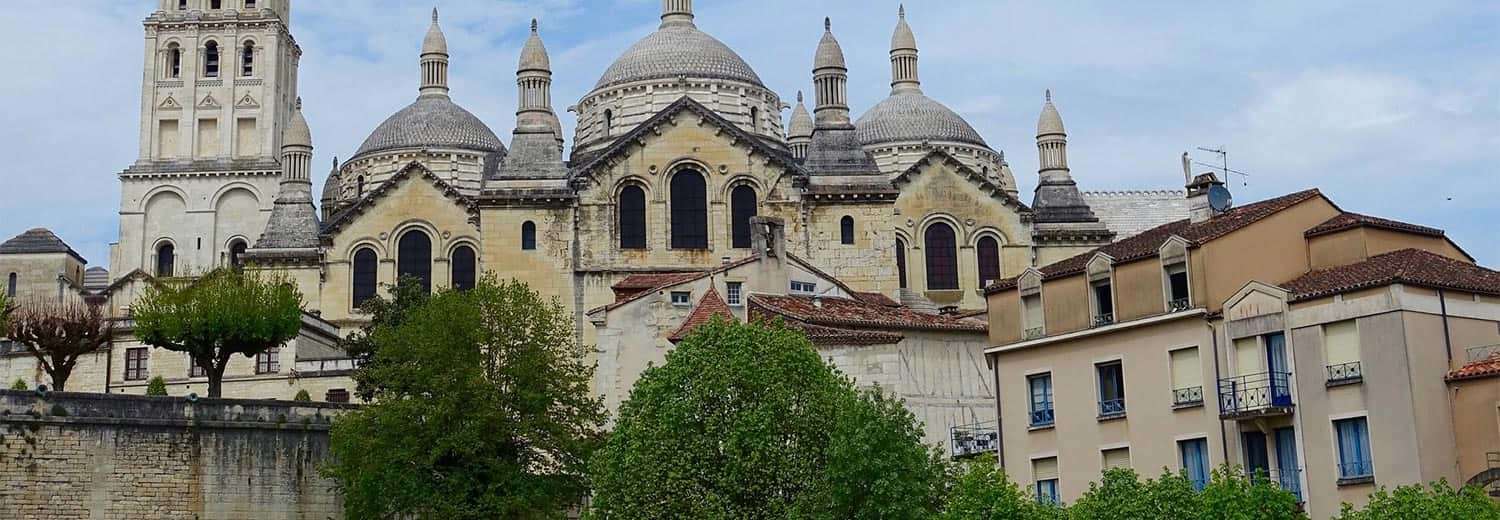GET A QUICK, FREE QUOTE
Rated 'Excellent'
on Trustpilot
ECMT International
Removals Permit
British Association
of Removers
Eco Friendly
Removals
Our Removals Service Includes…
For removals to and from Périgueux.
Call Now 0808 175 1966
Périgueux
Vibrantly green city is a blooming marvel of the Dordogne
The city of Périgueux seems always to be in bloom. Flowers are grown here in the municipal greenhouses to provide colour whatever the season and all year round its streets offer a welcoming blast of nature.
It is one of only nine places to be awarded four flowers in the France in Bloom – the council works hard here to maintain a litter-free, leafy appearance.
All around the city there are luscious green spaces, including Jardin des Arènes, Parc Gamenson, Parc de Vésone, Jardin du Thouin, Jardin des Remparts, Jardin des Vagabondes, Jardin de la Source and Grand Prairie Puy Bernard. The François-Mitterrand park along the boulevard Georges-Saumande is the only site in the department to be awarded the title of Eco-garden in 2016.
Superlative architecture is all around here, with historic buildings and ancient remains rubbing shoulders with all the modern facilities you could wish for.
There is a daily market with fresh fruit and vegetables in the 19th century covered market on Place du Coderec. This bustles with life, as the city’s residents (population nearly 30,000) go about their daily lives.
Perigueux boasts a stunning Byzantine cathedral, with a cluster of domes which can be seen from all around the city. It has a Greek cross ground plan like St Mark’s cathedral in Venice and the Sacré Coeur church at Montmartre in Paris. The cathedral has been designated a UNESCO World Heritage Site.
A Roman villa is at the centre of the city’s museum, preserved for people to almost walk around – you can see where the Romans installed underfloor heating.
There are also the remains of an amphitheatre here, transformed into gardens with a fountain.
The Dordogne general council sit here, as does the Assize Court of the Dordogne. The city has a district court, a high court, a commercial court, an industrial tribunal and a juvenile court.
Périgueux is the main employment area in the Dordogne and is home to the head offices of several regional companies. One of the main employers is the workshops of the railway company SNCF.
Apart from the day to day activities of its residents Périgueux is also a tourist magnet, with various festivals and cultural events hosted here. Foodies make a beeline for Périgueux too – it is renowned for its gastronomy.
Périgueux is crossed by the Isle, the main tributary of the Dordogne. The river is nearly 160 miles long and much of it is navigable.
You might want to buy that boat, as Périgueux suffers from fairly heavy traffic – the result of its having six bridges around the city – just one per mile of river.
Or take a train – Périgueux Train Station is part of SNCF and here you can board a train for Bordeaux, Limoges, Brive and Agen ; by main line trains to Paris, Lyon and, by Ventadour, to Clermont-Ferrand.
The history of Périgueux
There was originally a settlement here around 200 BC. People settled on the heights on the left bank of the Isle and created a fortified camp at La Boissière.
In 52 BC this encampment provided Vercingetorix with about 5,000 warriors, to help him face the Roman legions of Julius Caesar.
A few years later La Boissière camp was abandoned and the Gallo-Roman Vesunna, (the future Périgueux), was created between 25 and 16 BC. The Roman city grew prosperous and temples, baths, an amphitheatre and a forum were built.
Even as long ago as this, Vesunna is said to have had between 15,000 and 20,000 residents. It became capital of the city of Pétrocores at the end of the third century.
In the fifth century, the Normans looted the city repeatedly. Then towards the end of the tenth century a new centre started to appear around a monastery. Walls were built around this new centre to protect the city.
Around 1150, Boson III, known as de Grignols, had a large and strong tower built to monitor the city he had just captured. But this angered King Henry II of England, who had by then become Duke of Aquitaine by marriage. The tower was destroyed in 1182. Henry’s son Richard destroyed all the fortifications built by him and his predecessor.
The city became Périgueux in 1240, uniting the two towns a few hundred metres from each other –the Gallo-Roman Vésone and the count of Périgord and the bourgeois city of Puy-Saint-Front.
In the 13th century, new bourgeois settled in Périgueux and bought plots of land to build on.
Cloth merchants also came to settle in Périgueux, acquiring much land in the city.
The wars of religion were more deadly for Périgueux than the Hundred Years War. Périgueux was taken on August 6, 1575 by Calvinists, who plundered and occupied the city. That same year, the remains of the holy bishop were stolen, taken to the Castle Tiregand and thrown into the Dordogne.
Périgueux remained in Protestant hands until 1581.
In 1857, Périgueux saw the arrival of the railway and from 1862, repair shops for the locomotives and cars.
In 1939, following the advance of German forces in Alsace and Lorraine, many thousands of people were evacuated here. Périgueux welcomed thousands of Strasbourg residents – you can see Strasbourg town hall at 2 rue Voltaire, at the Chamber of Commerce. Administrative services returned to Strasbourg in July 1940 but the mayor Charles Frey stayed in Périgueux until November 1944.
The Resistance grew in the city with movements and networks created to distribute false papers and underground newspapers.
On November 11, 1942, German troops invaded and settled in Daumesnil, forcing the 26th Infantry Regiment to dissolve six days later. The Gestapo moved to the current Place du Général de Gaulle.
The Resistance activities intensified in 1943, causing a bomb attack on the Gestapo headquarters on October 9. Rreprisals were immediately triggered, leading to the arrest of 17 resistance fighters. On November 9 a fresh attack on the Germans at the main office of the gendarmerie, caused extensive damage and injuries.
On May 10, 1944, the militia and the Vichy police arrested and gathered 211 people in the Palace room, then transferred them to the sites of the Atlantic Wall to perform forced labour. On D-Day, when the Allies landed in Normandy, the Perigord resistance fighters attacked. The Germans counter-attacked – killing more than 500 civilians. In August Hitler decided to withdraw his troops in the south of France. But they didn’t leave quietly – they shot 35 resistance fighters and 14 PoWs before leaving on August 19, 1944.
After heavy rains melted the snow, the Isle suffered a 100-year flood and reached four-and-a-half metres on December 8, 1944. There were 7,000 victims and a third of Périgueux was flooded.
By the next year relations with Germany were starting to heal. In 1945, Hans Kowar, a German prisoner of war was working in Bergerac, on a farm of the priest Henri Cellerier, who taught German language in Périgueux. The two men become friends and Kowar introduced his town, Amberg, to Cellerier. In 1961, a Perigord municipal delegation went to Amberg and the twinning was formalised on October 2, 1965. Many exchange visits and events have taken place since.
Following the 1939 evacuation of 80,000 Alsatians to the Dordogne – mainly in Périgueux for Strasbourg people – one in five remained in Périgord.
Removals service
Armishaws can move you to or from anywhere in the UK or Europe. We have lots of fully-trained staff and a fleet of modern vehicles.
Armishaws always work to the highest standards – we have held the BSEN 12522 certificate since 1999.
Why Choose Armishaws for your move
- Up the road or round the world – up to you!
- Part loads undertaken
- Shipping around the world
- Moving to France, Spain and Portugal? We know what we’re doing!
- Storage services
- Friendly staff
- We can wrap and pack for you
- The Armishaws family have been in removals since 1973
- Free surveys and same day quotes available
Armishaws can design a service to fit any need. We have multiple branches and we are the best local choice, with a reliable team providing a fantastic value service to make moving or storing your possessions a piece of cake. We have loads of experience in helping with moves to anywhere and everywhere.
For Free Advice and a Quotation call 0800 917 1015
Why move to Périgueux?
It’s achingly beautiful here, and well connected to the rest of France and beyond. There’s nothing to dislike!
Properties in Périgueux
To view properties for sale click aplaceinthesun.com and french-property.com.
Transport Links
The Périgord agglomeration is served by Péribus – 11 main lines and a network of 14 low frequency secondary lines. A free electric shuttle operates in the city centre.
Périgueux-Bassillac airport is in Bassillac, five miles away.
The Périgueux canal was used to transport goods such as wood, coal, iron, cast iron, lime, barrels of wine, oil, walnuts, chestnuts, tiles, pottery, flour, etc. But theIsle was officially closed to navigation in 1957.
Périgueux railway station offers connections to Limoges, Bordeaux, Brive-la-Gaillarde, and other regional destinations.
Local Events
Périgueux’s vintage festival is held over three days at the end of August. This is an amazing event with cars, music, costume and vintage items from the 1930s to 1970s. Local shops and residents go to town on vintage outfits and decorations.
In July and August, the Concours de la Truffe d’Argent is held, devoted to French-speaking songs, with several categories and trophies.
In August, the Sinfonia en Périgord Festival is devoted to baroque music. And the Macadam Jazz festival involves concerts around the city on Tuesdays in July and August.
St. George’s Day is celebrated on the first May weekend. All along rue Talleyrand-Périgord there are rides and fairground attractions and a fishing competition is organised. The event usually ends with a fireworks display.
The Périgueux Fair-Exhibition is held for nine days in September, at the Marsac-sur-l’Isle exhibition centre, with various events and conferences.
The city’s carnival features a parade of floats throughout the city.
Every two years an, International Book Fair is held.
There are lots more festivals covering food, music and sports.
The international festival of mime is held at the end of July. Roller Boulevard evenings are held in June.
The Latin American Film Festival isin October and an International Solidarity Week takes place in November.
Périgueux has been a stage city of the Tour de France three times.
Several regional and even national competitions are held each year in Périgueux, involving all kinds of sports – rugby, petanque, cycling, tennis, golf and athletics.
Schools near Périgueux
The city has ten public nursery schools, one private nursery school, eight public elementary schools, and five private elementary schools.
The region manages three general and technological high schools, four vocational high schools and the department manages five colleges.
The Périgueux university site in Grenadière brings together training courses from the University of Bordeaux as well as the Higher School of Teaching and Education.
The Bertran-de-Born public high school has preparatory classes for the major literary and scientific schools (PCSI and PC courses).














